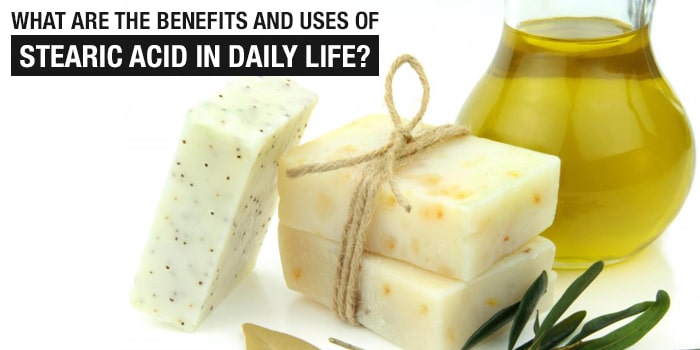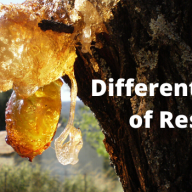Importance and Uses of Stearic Acid in Daily Life

We have all used stearic acid in our lives, albeit without knowing it. Most of us probably do not still not what stearic acid is, what are the uses of stearic acid, its benefits, what it looks like, and so on and so forth.
What is Stearic Acid?
So first let us understand what stearic acid is. It’s a wax-like solid that is either white or colorless and has a bit of an unpleasant smell. You can dissolve it in oil, however, it is quite difficult to dissolve it in water, as it is waxy. It is only partially soluble in water, and so if it is mixed with water, you will find it floating on the water.
According to chemistry, stearic acid has an 18 carbon chain, and is also called Octadecanoic acid; it is what is referred to as a long-chain fatty acid. ‘Stear’ is actually a Greek word, and it refers to the fats that are produced as a by-product while meats are processed – known in English as tallow.
However, all stearic acid is not necessarily animal in origin – plant-based stearic acid is also available nowadays. You can get it from the fatty parts of plant sources as well, making it ideal for use in cosmetic products like shea or cocoa butter. Palm oil is the most common plant source, though there are others too. This natural ingredient makes cosmetics and toiletries safer to use than those with an overabundance of chemicals.
Animal fat is typically made up of 30% stearic acid. Plant-based oils like palm oil or coconut oil contain 5% stearic acid in the total volume – shea butter and cocoa butter however, contain almost 40 to 50% stearic acid. In India, stearic acid suppliers mainly deal with plant-based stearic acid as the majority of the people prefer to use such products rather than those that contain animal ingredients. In fact, most stearic acid available commercially contain almost an equal amount of palmitic acid and a tiny amount of oleic acid as well.
Stearic acid is primarily used for the manufacture of stearic acid triple pressed salt: sodium stearate, stearate from magnesium, calcium stearate, lead stearate, stearate from aluminium, cadmium stearate, iron stearate and stearate from potassium.
Widely used in the manufacturing of cosmetics, polymer plastic agents, release agents, surfactants, rubber vulcanization accelerators, polishers, metal soaps, mineral flotation agents, pharmaceuticals and any other organic chemicals Widely used to produce cosmetics.
How Does Stearic Acid Work?
Stearic acid is used to manufacture products like emulsifiers, lubricants, ointments, lotions, emollients, and so on. Stearic acid effectively stabilizes, thickens and softens, helping to create a cooling sensation when the moisturizer or ointment is applied on the skin. Stearic acid also lends a smooth, pearl-like finish to lubricants.
Stearic Acid Uses in Daily Life

1. Soaps, Shaving Creams and Detergents
Stearic acid is used to harden and thicken products like bars of soap and candles. The presence of stearic acid in soap helps to create a lather when mixed with water, providing a velvety feeling; it is this property that also makes it a must-have ingredient in most shaving foams and creams as well. When the soap formula is hardened into a solid, it helps to do away with the watered-down, runny feeling. This is brought about by the surfactant action that brings down the surface tension of a given oil; when the surface tension is reduced, oil and water can be mixed much better, and do not split into layers of oil and water.
Stearic acid has occlusive properties which means that it ensures hydration for the skin through the prevention or delaying of loss of moisture from the surface of your skin.
When you are using a product that contains stearic acid, you don’t have to shake it vigorously before you use it; the presence of stearic acid in a product helps to extend not only its effectiveness, but also its shelf life. It is the stearic acid that works to dislodge the grime, sweat and extra oil from your hair and skin when you apply shampoo, soap, face wash or body wash.
This cleansing feature of stearic acid is also the reason it is used in detergent powders and liquids – it does the work of cleaning your clothes.
Any cleansing product that contains stearic acid is endowed with conditioning features in addition to the cleansing ability; add that to the preservative traits, it helps to increase the effectiveness and shelf life of the final product in which it is used.
In shampoos, the stearic acid content helps to soften the hair and render it glossy and light.
2. Lotions, Moisturizers, and Face Creams

The use of stearic acid in lotions and creams is essential as it helps to add thickness to the product, and gives it a rich, lustrous finish. It also leaves a smooth, velvety feel on the skin when the product is applied. If you carefully check the labels of face creams and moisturizers, you will be able to read that it contains stearic acid.
3. Candles

We have already seen that stearic acid resembles wax, and that when added to products, it helps to harden and solidify them. This makes them ideal for addition to paraffin candles. The advantage is that a hard candle lasts longer, because fire will take a much longer time to melt a hard candle as compared to a soft one. As the wax cools down, stearic acid shrinks it, allowing it to be released easily from a mold. With so many people taking up candle making as a home industry, there are many fancy shapes of candles being made, and these are all made in molds. With complicated mold shapes, it can become difficult to pry out candles – but the slight shrinkage brought about by stearic acid makes the process easy.
However, the uses of stearic acid do not end here – it has opacifying characteristics; this means when dyes are added to candles, it helps to make the color brighter and more vivid.
Available for the manufacture of cosmetics, plastic cold plasticisers, release agents, surfactants, accelerators of rubber vulcanization, polishing agents, metal soap, floaters of metal minerals, softeners and other organic chemical agents
The fat cells present in stearic acid attach themselves to the cells of the fragrance added to the candle. This helps the fragrance to last longer as the aroma as it prevents the aroma from gushing out of the candle in one go. Candles contain about 3 to 5% stearic acid.
4. Casts and Molds
As it is a gentle chemical, the uses of stearic acid can be found in industrial applications as well. It is often used to make castings and molds; the castings are usually made from a piece of plaster, or broken/waste mold; shellacked clay is used to make a mold using stearic acid. Here, stearic acid is powdered and mixed in water; this mixture is then applied to the surface that will be separated once the casting is over. This solution has a chemical reaction with the calcium present in the plaster, and forms calcium stearate; this chemical helps to release the cast easily and quickly. Stearic acid is commonly used as a lubricant in the process of injection molding and pressing of ceramic powders, and to release mold for foam latex when it has been baked in molds made of stone.
5. Rubber
The stearic acid of rubber grade that we offer comes from well-known organisations. This rubber grade stearic acid is used in the processing of the rubber compound as a dispersing agent, plasticizer and lubricant.
6. Paints & Coatings
Stearic acid is used directly in some paints in the paint sector, for example in cement paints and that is indirectly in different formulations of the coating such as zinc stearates, additives, etc.
7. Plastics

Stearic acid, as a good gravity and light and heat stability, is commonly employed for PVC pipe, platform, profile, film manufacturing, heat stabilizer manufacturers.PVC plastic tube, stearic acid, is an efficient method for adding a heat stabilizer to the processing of the “coke” in a PVC film and can cause sulfide-finished film de-colouration due to a protection storm. Stearic acid is applied in plastics as a lubricant and reduction of friction.
8. Playing Cards
When stearic acid reacts with zinc, zinc stearate is formed; this is used as ‘fanning powder’, which helps lubricate playing cards, and helps in smooth shuffling, fanning and so on, of the cards.
9. Batteries
In the making of lead-acid batteries, stearic acid is used as a negative plate additive, as it helps to improve the plate’s hydrophobicity, especially when the battery has to be dry-charged. The stearic acid helps to reduce the oxidation extension of the negative active material, or the lead which forms afresh when the plates are left to dry in the open after the tank formation process is completed. This helps to reduce the time required for charging a dry battery for the first time considerably, when compared to a battery that does not feature added stearic acid in its plates.
10. Fireworks
Stearic acid is also often used in fireworks for coating aluminum, iron, and other metal powders. This helps to prevent or delay the onset of oxidation, and extend the shelf life of the compositions. You can store them for longer periods of time.
Contraindications
Stearic acid is generally not meant to be consumed, and is for exclusive external use. If consumed, it can cause chemical pneumonitis. People with especially sensitive respiratory systems, high vulnerability to allergies, pregnant and nursing mothers, and so on, should take special care if they have to handle stearic acid in the raw form, and are advised to seek medical consultation beforehand. Raw stearic acid should not be left in places easily accessible to children under the age of 8. Chemical suppliers in India will give you all the information regarding safe handling of the material when you purchase the raw material.
Stearic acid in its raw form can cause the skin to itch, sting, or break out in hives, rashes, blisters, and become red and scaly.
If you have a soap making or candle making business or need stearic acid for other industrial purposes, you can contact reputed chemical distributors in Delhi for rates, terms of payment, shipping, and more. Bansal Trading Company is one of the leading and renowned dealers of chemical substances in India.
Read Other Blogs –Application Of Glycerin in Cosmetics and Pharmaceutical Industry
BTC_WEB_ADMIN










